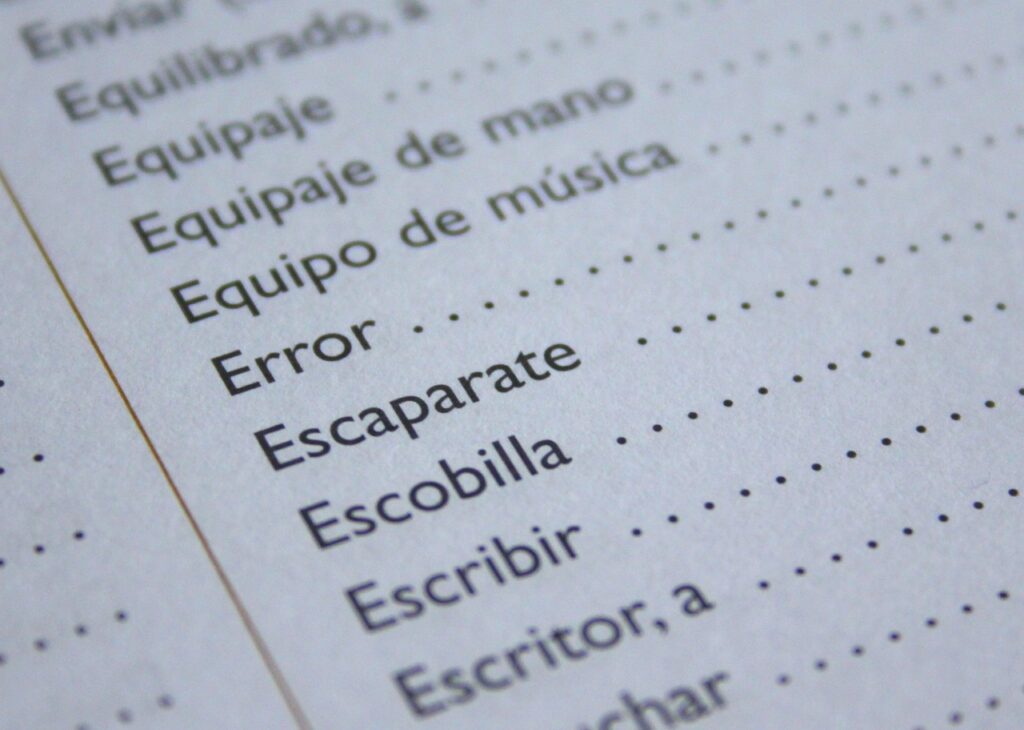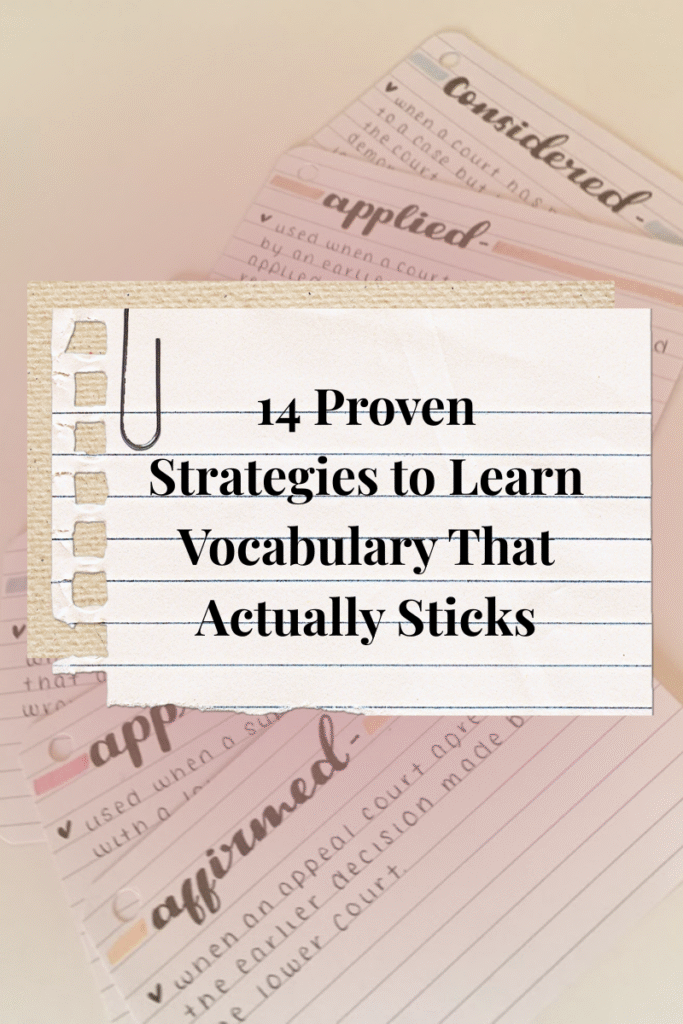Have you ever wondered how many times you need to see or hear a new word to learn vocabulary effectively?
Some people say it’s enough to see a word once, others think five or ten times. But according to studies in educational psychology, the average is between 15 and 20 exposures. That means you need to come across a word again and again—in reading, listening, speaking, and writing—before your brain fully adopts it.
And here’s the trick: not all words need the same number of repetitions. Some words you’ll remember instantly (especially if they’re funny, emotional, or personal to you), while others might need 30 or more encounters before they stick.
So the question isn’t just “how many times do I need to see a word?” but rather “what can I do to make sure I keep seeing and using that word until it becomes part of my active vocabulary?”
That’s where these 14 proven strategies to learn vocabulary effectively come in. Each one is designed to make vocabulary practice not only effective but enjoyable.

1. Learn Words in Context
Your brain doesn’t like random word lists—it learns best when new terms are connected to real-life situations. Instead of memorizing “mesa = table,” use it in a full sentence: “La mesa de mi cocina es blanca.”
When you learn vocabulary in context, you give your brain a story or situation to hook the word onto, which makes it much easier to remember. Context shows you not just the meaning of the word but also how it’s actually used in everyday language.
Try this: Every time you learn a new word, write 2–3 short sentences about your own life. For example, if you’re learning libro (book), you might write: “Este libro es muy interesante” or “Tengo un libro en mi mochila.” This practice helps you build active vocabulary that you’ll be able to use naturally in conversations.
2. Use Spaced Repetition (SRS)
To learn vocabulary effectively, timing matters. Instead of repeating words daily, the Spaced Repetition System (SRS) helps you review them at increasing intervals (1 day, 3 days, 1 week, etc.). This strengthens memory and makes words part of your active vocabulary.
Tools like Anki, Quizlet, or Memrise automate the process and remind you when it’s time to review.
Try this: Add 10 new words into Anki this week and let the app guide your reviews. You’ll remember new vocabulary more naturally without cramming.
3. Personalize Every Word
The more personal a word feels, the stronger your brain remembers it. Instead of just memorizing correr = to run, make it real: “Corro cada mañana en el parque cerca de mi casa.” When you learn vocabulary in context and tie it to your own life, you create stronger connections that move words into your long-term memory and active vocabulary.
Try this: Each time you add a new word, ask yourself: How would I actually use this in my daily life? Write 2–3 personal sentences. This way, you’re not just learning translations—you’re building usable vocabulary you’ll recall naturally in conversations.
4. Daily Micro-Sessions
When it comes to learning vocabulary, consistency beats intensity. Studying just 10 minutes a day is far more effective than cramming for 2 hours once a week. Your brain prefers small, regular doses of input.
Try this: Review new words during short moments—on the bus, waiting for coffee, or before bed. Set a 10-minute timer each morning, pick 5 words, say them aloud, and make quick sentences. This routine helps you build vocabulary daily without overwhelm.
5. Mix All Four Skills (Read, Write, Listen, Speak)
The more senses you involve, the stronger your memory of new words. To learn vocabulary effectively, make sure each word passes through at least two different skills in the same day.
Example with lluvia (rain):
- Read: “La lluvia es fuerte hoy.”
- Speak: Say it out loud.
- Listen: Notice it in podcasts, songs, or videos.
- Write: Journal about “a rainy day.”
Try this: Each time you add a new word, don’t just read it—say it aloud, listen for it in real content, or write with it. Using multiple skills helps you remember vocabulary faster and prepares you for real conversations.
6. Mnemonics & Funny Associations
Absurd or funny images make it easier to remember new vocabulary because your brain loves unusual connections. For example: llave (key) → imagine a giant golden key opening your favorite café. That silly mental picture will stick much longer than just the translation.
Try this: If you struggle with a word, invent the weirdest image or story you can. The funnier or more absurd, the better—it’s a proven trick to learn vocabulary faster and make it unforgettable.
7. Read & Listen to Real Content
One of the most effective ways to learn vocabulary in a new language is through real-life exposure. Authentic materials like podcasts, news articles, or even short stories show words in their natural context—not just isolated lists. This helps you understand not only meaning but also usage and tone.
Try this: Choose an article, YouTube video, or podcast episode in your target language. Highlight 5 new words you notice more than once. Write them down, check their meaning, and review them at the end of the day. This method of learning words in context makes them easier to remember and more practical for real conversations.
8. Group Words into Families
A smart way to expand your vocabulary in a new language is by learning word families instead of single words. For example, from emplear (to employ), you also get empleado (employee) and empleo (employment). This method not only multiplies the words you know but also helps you see patterns in language learning, making recall faster.
Try this: Each time you add a new word, check its variations—verb forms, nouns, adjectives, or related expressions. You’ll often learn 3–4 words in one go, which builds a stronger and more connected vocabulary network.
9. Create Concept Maps
If you’re a visual learner, concept maps are one of the best tools for memorizing vocabulary in language learning. Instead of seeing a word in isolation, you connect it to synonyms, antonyms, and related expressions. For example: happy → joyful, glad, cheerful / opposite: sad. These networks make your brain store words more efficiently.
Try this: Take one new word and draw a simple web. Add synonyms, opposites, and even example sentences. By creating these visual vocabulary connections, you’ll build a stronger memory and expand your word bank faster.
10. Use Dialogues & Mini-Stories
Our brains remember stories far better than isolated facts. That’s why using dialogues or short narratives is a powerful method to learn vocabulary in a new language. Stories activate emotion and context, which makes words stick longer in memory.
Try this: Take 8–10 new words you want to learn and create a short, silly 5-sentence story using them. Or write a mini-dialogue as if two characters are talking. You’ll naturally remember the story—and with it, the vocabulary. This technique turns dry word lists into memorable experiences.
11. Speak Words Out Loud
When it comes to language learning and vocabulary retention, silent reading isn’t enough. Saying words aloud activates your auditory memory and reinforces correct pronunciation, making the word easier to recall in real conversations.
Try this: Each time you review flashcards or a vocabulary list, say every word out loud. Even better—record yourself on your phone and play it back. This way, you practice speaking, listening, and memorizing all at once.
12. Label Your World
Transform your surroundings into a living vocabulary lab. By labeling everyday objects with their names in your target language, you get constant visual exposure and repeated reinforcement. This method is perfect for visual learners and helps connect words directly to real-life objects instead of just a dictionary definition.
Try this: Place sticky notes on common household items (e.g., puerta = door, ventana = window, espejo = mirror). To avoid “label blindness,” swap or update the notes every week. You can even color-code them: green for nouns, blue for verbs, yellow for adjectives.
13. Read a Lot (But Actively)
Reading is one of the most effective ways to expand vocabulary in context, but passive reading isn’t enough. To truly remember, you need to engage actively with new words.
Try this: While reading books, articles, or blogs, highlight 3–5 new words per session. Don’t just translate them—create your own example sentences to lock them into memory. Tools like ReadLang, LingQ, or Kindle highlights make it easier to track and revisit words.
14. Focus on Useful Vocabulary First
When building your vocabulary, prioritize frequency and relevance. Rare words (like azada = hoe) won’t serve you much if you haven’t yet mastered core vocabulary like corto (short) or largo (long). Learning the most common words first gives you the biggest communication payoff.
Try this: Begin with the top 1000–2000 most frequent words in your target language. Then, branch into domain-specific vocabulary that matches your interests. For example, if you’re into fitness, focus on entrenar (train), fuerza (strength), estiramiento (stretch).
Final Thoughts
Learning vocabulary is less about “memory tricks” and more about creating the right conditions for words to stay in your brain. Science says you need to see or hear a word 15–20 times before it sticks, but by using these strategies, you can make those exposures fun, personal, and effective.
Challenge for you: Choose 10 new words this week. Apply at least 3 of these strategies to them. By next week, you’ll notice they don’t just look familiar—they’ll feel like part of your active vocabulary.

I’ve used these strategies in my own languages learning journey and They really work.
That’s wonderful! I’ve also noticed big progress when I apply them consistently.
Learning new words isn’t easy, but it’s possible with the right methods. Which tip will you try first?